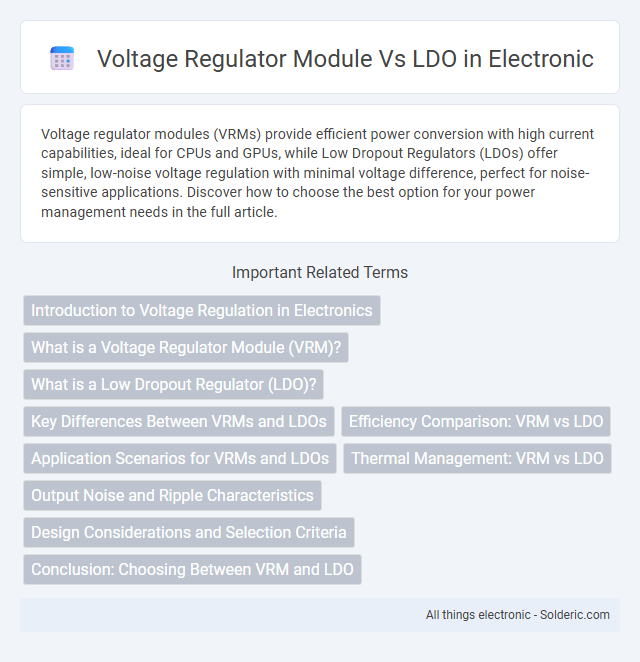Voltage regulator modules (VRMs) provide efficient power conversion with high current capabilities, ideal for CPUs and GPUs, while Low Dropout Regulators (LDOs) offer simple, low-noise voltage regulation with minimal voltage difference, perfect for noise-sensitive applications. Discover how to choose the best option for your power management needs in the full article.
Comparison Table
| Feature | Voltage Regulator Module (VRM) | Low Dropout Regulator (LDO) |
|---|---|---|
| Function | Converts input voltage to stable output voltage with high efficiency | Regulates voltage with very low dropout voltage |
| Efficiency | High (typically 80-95%) | Lower (typically < 60%) |
| Dropout Voltage | Higher dropout voltage | Very low dropout voltage (as low as a few millivolts) |
| Output Noise | Higher output noise | Low output noise and ripple |
| Size | Larger size due to more components | Compact size, fewer components |
| Cost | Higher cost | Lower cost |
| Typical Application | High power applications, CPUs, GPUs | Low noise analog circuits, RF components |
Introduction to Voltage Regulation in Electronics
Voltage regulation in electronics ensures stable power supply to sensitive components by maintaining consistent output voltage despite variations in input or load. Voltage regulator modules (VRMs) are efficient switching regulators ideal for high-current applications, offering better thermal performance and energy efficiency compared to linear solutions. Your choice between VRMs and Low Dropout Regulators (LDOs) depends on factors like noise tolerance, power dissipation, and the required voltage stability for your specific electronic device.
What is a Voltage Regulator Module (VRM)?
A Voltage Regulator Module (VRM) is a compact power supply unit designed to efficiently convert and manage voltage for high-performance processors and memory components in computers. VRMs provide precise voltage regulation with high current capacity and fast transient response, making them essential for maintaining system stability under varying loads. Your system benefits from VRMs through improved power efficiency and reliable voltage delivery compared to simpler regulators like LDOs.
What is a Low Dropout Regulator (LDO)?
A Low Dropout Regulator (LDO) is a type of voltage regulator module designed to maintain a steady output voltage even when the input voltage is very close to the output voltage, minimizing power loss and heat dissipation. LDOs are especially effective in battery-powered devices where efficiency and compact design are critical. Your choice of an LDO can directly impact the performance and longevity of sensitive electronic components by providing clean, stable voltage with low noise.
Key Differences Between VRMs and LDOs
Voltage regulator modules (VRMs) typically provide higher efficiency and better thermal management for delivering stable voltage under varying loads, making them ideal for complex electronics such as CPUs and GPUs. Low dropout regulators (LDOs) offer simpler design, lower noise output, and fast transient response but with lower efficiency, suitable for low-power and noise-sensitive applications. Your choice will depend on the voltage stability requirements, power efficiency, and thermal constraints of your specific electronic project.
Efficiency Comparison: VRM vs LDO
Voltage regulator modules (VRMs) typically offer higher efficiency than low dropout regulators (LDOs) because VRMs use switching mechanisms that minimize power loss, making them ideal for applications requiring significant voltage step-down with minimal heat generation. LDOs, while simpler and quieter, suffer from lower efficiency as they regulate voltage through linear dissipation, which results in more heat and wasted energy, especially at larger voltage differences. Choosing between a VRM and an LDO depends on Your need for power efficiency and thermal management in the specific electronic design.
Application Scenarios for VRMs and LDOs
Voltage Regulator Modules (VRMs) are ideal for powering high-performance CPUs and GPUs due to their ability to efficiently handle high current loads and rapidly changing power demands. Low Dropout Regulators (LDOs) are commonly used in applications requiring low noise and minimal voltage ripple, such as RF circuits, sensors, and battery-powered devices. VRMs excel in scenarios demanding high efficiency and thermal management, while LDOs are preferred for simplicity and noise-sensitive analog components.
Thermal Management: VRM vs LDO
Voltage regulator modules (VRMs) typically feature integrated thermal management systems such as heatsinks and improved airflow design to dissipate heat efficiently during high current loads. Low dropout regulators (LDOs) generate less heat due to their linear operation but can suffer from thermal throttling in high voltage drop scenarios, limiting their effectiveness. Choosing between a VRM and LDO depends on your thermal constraints and power efficiency requirements, with VRMs being preferable for high-power, heat-intensive applications.
Output Noise and Ripple Characteristics
Voltage regulator modules (VRMs) typically exhibit higher output noise and ripple compared to Low Dropout Regulators (LDOs) due to their switching operation, which can introduce high-frequency noise into sensitive circuits. LDOs provide cleaner, low-noise output with minimal ripple, making them ideal for noise-sensitive applications such as RF or audio devices. Your choice between VRM and LDO should consider the noise tolerance of your load and the importance of ripple suppression in your power supply design.
Design Considerations and Selection Criteria
When selecting between a voltage regulator module (VRM) and a low dropout regulator (LDO), key design considerations include efficiency, output voltage precision, and thermal management. VRMs are preferred for high-current applications requiring significant voltage step-down with better efficiency, while LDOs excel in low noise, low ripple environments with minimal voltage difference between input and output. Your choice depends on factors such as load current, dropout voltage, power dissipation, and space constraints in your electronic design.
Conclusion: Choosing Between VRM and LDO
VRM offers higher efficiency and better performance for applications requiring substantial current and voltage conversion, making it ideal for CPUs and GPUs in high-power systems. LDO regulators provide simpler design, lower noise, and faster transient response, best suited for low-power, noise-sensitive applications like RF circuits and analog devices. Selecting between VRM and LDO depends primarily on power efficiency needs, voltage conversion requirements, and system complexity constraints.
voltage regulator module vs LDO Infographic

 solderic.com
solderic.com